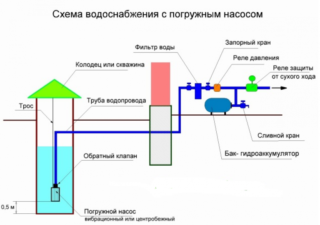Life in a country house can be as comfortable as in a city apartment if you equip engineering communications. Those who want to maintain a high quality of living cannot do without proper water supply. It is important to comply with all sanitary and construction standards during design and installation so that the system works smoothly for many years.
Regulatory Requirements
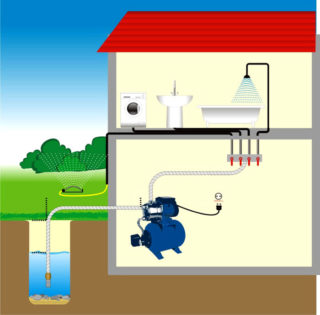
For private one-family buildings, the requirements are spelled out in SNiP 31-02. In addition to building standards, sanitary and hygienic requirements are also taken into account, as well as compliance with GOST of all building materials, especially pipes and fitting elements.
Particular attention should be paid to stop valves. It is installed on connections to faucets, household appliances, cisterns and washbasins.
In order for the system to function correctly, you will need to install a plunger - a device that will release air bubbles. It is also recommended to equip the water supply system with a bypass - a spare water supply line in case of emergencies.
Types of water supply systems in a private house
The central water supply system is used for the mass supply of water to consumers from a single grid in the city and urban settlements. However, it is possible to connect houses in rural areas to the main road, subject to technical conditions, but this rarely happens.
If it is not possible to connect to the city-wide water main, it becomes necessary to create an independent type of system in a country house.
A typical water supply scheme for a private house looks like this:
- A well or a well shaft is equipped with a submersible pump; a main water supply is connected to it.
- The pipeline is laid and led into the house.
- The water supply network is connected to a cleaning filter, an automation unit and a hydraulic accumulator.
From the pumping equipment, clean water is distributed to consumers.
Autonomous water supply systems are suitable for private cottages with a small amount of plumbing. They are winter and summer. The first option implies a major water supply in houses with permanent residence. The second is used for seasonal work: automation of watering the garden, supplying water to an outdoor shower, a country house, a bathhouse. The installation price is correspondingly much lower, 10,000-15,000 rubles may be enough. Prices for carrying out a major water supply system in a private house start at 85,000 rubles.
The cost can be influenced by the building material. For example, it is easier to conduct water in a frame house than in a wooden or brick house, which means it is cheaper.
Features of the external water supply
In places with systematic voltage drops in the electrical network, the creation of a water supply network is carried out using a storage device. This type of decentralized system functions as follows:
- In the highest place of the building, for example, in the attic, a storage tank is installed.
- The pipeline is connected to a submersible-type submersible pumping device, which is located in a well or well shaft.
- The water supply from the source is led into the building.
- The home outdoor system is connected to the inlet of the accumulator.
- Using a pumping unit, water is pumped into the container. When the battery is completely full, the pump should shut off automatically.
- When the water pressure reaches a minimum, the automatic system is triggered and the pump turns on again.
If the water supply lines are laid in an area with significant relief differences, the arrangement of a single system is irrational. When water is drained from the highest point in the lower part of the pipeline, the liquid will be under a strong pressure that can destroy communication structures. In such a situation, a zone pipeline is created. The number of zones and methods of installation of pressure equipment depend on the topography of the site and the pressure of the water flow at each site.
Nuances of intra-house wiring
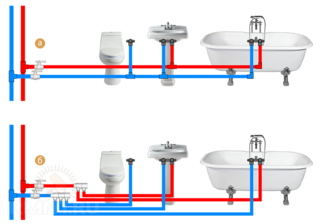
The in-house pipeline is the main line and the branches connected to it. They pass inside the building and water consumption points are connected to them. For laying, a careful study of the floor plan of the building, basement or technical underground will be required.
Water can be supplied to consumption points in two ways. Depending on the parameters of the system, as well as on how intensive the use of water will be, the choice of the wiring scheme is determined.
By connecting in series or by means of tees, it is meant that the faucet, shower and other "wet" points are connected one after the other.
The advantages of this method:
- ease of installation - no special knowledge is required when connecting additional elements;
- low price - the number of pipes used is halved;
- compactness - tees are placed directly near the water intake points.
But there are also disadvantages. With the simultaneous inclusion of all water consumers, the pressure indicator in the water supply system is significantly reduced. In addition, when connecting a new point, problems may arise. You will need to cut in another tee.
Connecting in parallel by means of a manifold is the installation of one or two branching units - for pipes for hot and cold water supply. Branches for each consumer are connected to them. To create a water supply system of this type, you will need more pipe sections, but at the same time it allows you to configure the system to supply water with a stable pressure.
Advantages of connecting through a manifold:
- convenience - all nodal points are collected in one place;
- reliability - one pipe goes to each consumer, which significantly reduces the risk of leaks;
- pressure stability - the manifold provides a uniform head for all users, therefore, even with the simultaneous opening of all taps, the pressure in the network will not change.
The disadvantages include the high cost due to the increased consumption of materials and the need to allocate space for the installation and connection of collectors.
Design work
So that in the future you do not have to redo the main nodes, you will need the correct drafting of the water main project. It should indicate all points of water consumption, passages and valves. The drawing is marked with the dimensions of the pipes, the location of the water heater and pumping equipment.
In the same place, it is necessary to indicate the lines of gravity or pressure sewerage: where the drains will be connected - to a centralized system or a cesspool, a septic tank, a deep cleaning station.
When choosing pipes, fitting parts, you need to calculate the throughput of pipes depending on the cross section, length of the water supply and pressure. This is where tables, formulas and computer programs come to the rescue.
Installation steps
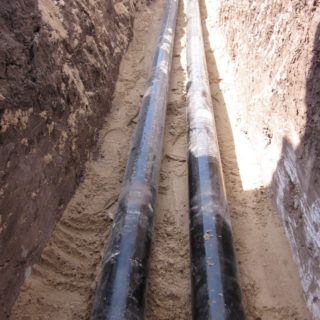
The installation of polypropylene, PVC, HDPE or metal-plastic pipes can be carried out independently. First, the outer part of the line is assembled with the connection of pumping equipment, then the internal pipeline.
When performing work, special equipment is not needed, all the tools are available in the home workshop. This is a pipe cutter and shovel for outdoor work, press pliers for crimping bushings that are put on the pipe. If the connection is made by hot welding, you will need a device with nozzles for soldering pipes. Of materials other than pipe sections and shaped components, fum tape, sealant, gaskets may be required.
Installation of external piping
The installation of an external network is carried out as follows:
- Dig a narrow trench with a depth of half a meter below the freezing level.
- At the bottom, a pillow is made of compacted quarry or river sand.
- Level the bottom with a slope of 20-30 mm per meter.
- Insulate the part of the water supply system, which is laid above the freezing level before entering the building.
- The pipe is installed and covered with clean sand and soil.
When entering the house, the pipeline is protected with a sleeve.
Internal branching
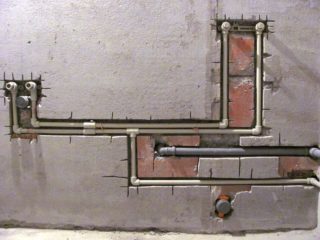
Installation is carried out as follows:
- The layout of the laying of the future pipeline is carried out - on the walls, in the screed or on the ceiling.
- Punching grooves in the walls or "bury" pipes in the floor screed. They are fixed on the ceiling with clips of the required size. When installing a water supply system on the floor, a distance must be observed - no more than 150 mm from the wall and no less than 200 mm from future furniture.
- The pipes are connected with fitting elements or soldering.
- Shut-off valves and a water heater, a booster pump, plumbing fixtures are connected.
The free space between the wall and the water supply system of about 15–20 mm will further facilitate the repair of the water supply line in the event of an accident or leakage. It is worth installing its own shut-off valve for each branch from the riser to the plumbing fixtures. So in the event of an accident, there is no need to shut down the entire system.
In order for all the systems and devices of the water supply network of a country house to work without problems, you need to responsibly approach the design work, choose high-quality building materials and strictly observe the installation technology.

